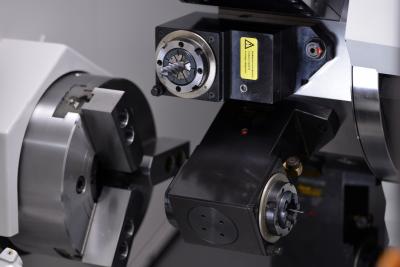
EXSYS Tool Inc. has expanded its line of PRECI-FLEX modular tooling systems to include a 10,000-rpm, 1:1 ratio rotary tool for Mazak QUICK TURN and QTU series turning centers. The faster toolholders effectively match the processing speed of optional 10,000-rpm machine spindles to boost productivity and impart fine surface finishes.
Manufactured by EPPINGER, PRECI-FLEX offers unmatched flexibility, precision and cost savings. The short, compact design with monoblock housing assures maximum torque transmission and rigidity, resulting in increased machining accuracy and improved productivity. Additionally, PRECI-FLEX's conical and flat face planar interface allows the use of either an adapter or a standard ER collet, and enables collets, endmill holders, expanding collet chucks and shrink-fit tooling to be mounted on a single base holder.
The tooling system also features an EXSYS/EPPINGER Compensating Clutch with a floating coupling between turret drive motor tangs and toolholders that automatically compensates for any misalignment. The resulting high-precision alignment reduces vibration and tool chatter, which, in turn, makes for longer tool life and better surface finishes.
Available in a range of sizes, the 10,000-rpm, 1:1 ratio PRECI-FLEX is available in horizontal (H) type 90-degree radial holders and vertical (V) type straight off-set axial holders. Every toolholder provides unsurpassed repeatability within five microns. The system also virtually eliminates machine downtime and allows tooling adapters to be interchanged between fixed and rotary base holders for fast, economical machining.
Contact Details
Related Glossary Terms
- centers
centers
Cone-shaped pins that support a workpiece by one or two ends during machining. The centers fit into holes drilled in the workpiece ends. Centers that turn with the workpiece are called “live” centers; those that do not are called “dead” centers.
- chatter
chatter
Condition of vibration involving the machine, workpiece and cutting tool. Once this condition arises, it is often self-sustaining until the problem is corrected. Chatter can be identified when lines or grooves appear at regular intervals in the workpiece. These lines or grooves are caused by the teeth of the cutter as they vibrate in and out of the workpiece and their spacing depends on the frequency of vibration.
- collet
collet
Flexible-sided device that secures a tool or workpiece. Similar in function to a chuck, but can accommodate only a narrow size range. Typically provides greater gripping force and precision than a chuck. See chuck.
- endmill
endmill
Milling cutter held by its shank that cuts on its periphery and, if so configured, on its free end. Takes a variety of shapes (single- and double-end, roughing, ballnose and cup-end) and sizes (stub, medium, long and extra-long). Also comes with differing numbers of flutes.
- flat ( screw flat)
flat ( screw flat)
Flat surface machined into the shank of a cutting tool for enhanced holding of the tool.
- modular tooling
modular tooling
1. Tooling system comprised of standardized tools and toolholders. 2. Devices that allow rapid mounting and replacement of tools. Commonly used with carousel toolchangers and other computerized machining operations. See toolchanger; toolholder.
- toolholder
toolholder
Secures a cutting tool during a machining operation. Basic types include block, cartridge, chuck, collet, fixed, modular, quick-change and rotating.
- turning
turning
Workpiece is held in a chuck, mounted on a face plate or secured between centers and rotated while a cutting tool, normally a single-point tool, is fed into it along its periphery or across its end or face. Takes the form of straight turning (cutting along the periphery of the workpiece); taper turning (creating a taper); step turning (turning different-size diameters on the same work); chamfering (beveling an edge or shoulder); facing (cutting on an end); turning threads (usually external but can be internal); roughing (high-volume metal removal); and finishing (final light cuts). Performed on lathes, turning centers, chucking machines, automatic screw machines and similar machines.

